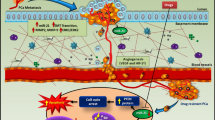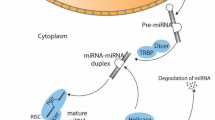Abstract
Background
Recently exposure to ionizing radiation driven by artificial radiation sources such as Medical X-rays and Nuclear medicine has increased hastily. Ionizing radiation-induced the DNA damage and activate the DNA damage response signaling pathways. The aim of this study was to evaluate the role of miR-21 and miR-625 in response to low-dose ionizing radiation.
Materials and methods
In this study, the blood sample of 38 volunteer patients who underwent Cardiac scans before and after 99mTc-MIBI injection were used. The WBC of patients was used for RNA extraction and after cDNA synthesis by the poly-A method the expression level of miR-21 and miR-625 was evaluated by real-time PCR method.
Results
The results of this study indicated that miR-21 and miR- 625 were significantly upregulated under exposure to low-dose ionizing radiation. The expression level of these miRNAs was not significantly correlated with the age and BMI of patients. More ever the bioinformatics analysis indicated that SP1 was a common target of both miRNAs and had the highest degree between hub genes.
Conclusion
In summary miR-21 and miR-625 can contribute to the response to acute low dose ionizing radiation by targeting the SP1. However further studies should be carried out on the molecular mechanism of effects of miR-21 and miR-625 in response to low dose ionizing radiation by targeting the SP1.



Similar content being viewed by others
Data availability
Data available on request due to privacy/ethical restrictions.
References
Bahreyni-Toossi MT, Vosoughi H, Azimian H, Rezaei AR, Momennezhad M (2018) In vivo exposure effects of (99m)Tc-methoxyisobutylisonitrile on the FDXR and XPA genes expression in human peripheral blood lymphocytes. Asia Oceania J Nucl Med Biol 6(1):32–40
Borrego-Soto G, Ortiz-López R, Rojas-Martínez A (2015) Ionizing radiation-induced DNA injury and damage detection in patients with breast cancer. Genet Mol Biol 38(4):420–432
Morgan WF, Bair WJ (2013) Issues in low dose radiation biology: the controversy continues. A perspective. Radiat Res 179(5):501–510
Mettler F, Huda W, Yoshizumi T, Mahesh M (2008) Effective doses in radiology and diagnostic nuclear medicine: a catalog 1. Radiology 248:254–263
Ouellette MM, Yan Y (2019) Radiation-activated prosurvival signaling pathways in cancer cells. Prec Radiat Oncol 3(3):111–120
Liang X, So YH, Cui J, Ma K, Xu X, Zhao Y et al (2011) The low-dose ionizing radiation stimulates cell proliferation via activation of the MAPK/ERK pathway in rat cultured mesenchymal stem cells. J Radiat Res 52(3):380–386
Pearce MS, Salotti JA, Little MP, McHugh K, Lee C, Kim KP et al (2012) Radiation exposure from CT scans in childhood and subsequent risk of leukaemia and brain tumours: a retrospective cohort study. Lancet (London, England) 380(9840):499–505
Lee JC, West MJ, Khafagi FA (2013) Myocardial perfusion scans. Aust Fam Physician 42(8):564–567
Sun Y, Ma P, Bax JJ, Blom N, Yu Y, Wang Y et al (2003) 99mTc-MIBI myocardial perfusion imaging in myocarditis. Nucl Med Commun 24(7):779–783
Gottschalk A (1969) Technetium-99m in clinical nuclear medicine. Annu Rev Med 20:131–140
Song M, Xie D, Gao S, Bai CJ, Zhu MX, Guan H et al (2020) A biomarker panel of radiation-upregulated miRNA as signature for ionizing radiation exposure. Life (Basel, Switzerland) 10(12):361
O’Brien G, Cruz-Garcia L, Majewski M, Grepl J, Abend M, Port M et al (2018) FDXR is a biomarker of radiation exposure in vivo. Sci Rep 8(1):684
Afshar S, Afshar S, Warden E, Manochehri H, Saidijam M (2019) Application of artificial neural network in miRNA biomarker selection and precise diagnosis of colorectal cancer. IBJ 23(3):175–183
Afshar S, SedighiPashaki A, Najafi R, Nikzad S, Amini R, Shabab N et al (2020) Cross-resistance of acquired radioresistant colorectal cancer cell line to gefitinib and regorafenib. Iran J Med Sci 45(1):50–58
Jovanovic M, Hengartner MO (2006) miRNAs and apoptosis: RNAs to die for. Oncogene 25(46):6176–6187
Bahreini F, Saidijam M, Mousivand Z, Najafi R, Afshar S (2021) Assessment of lncRNA DANCR, miR-145-5p and NRAS axis as biomarkers for the diagnosis of colorectal cancer. Mol Biol Rep 48(4):3541–3547
Moertl S, Mutschelknaus L, Heider T, Atkinson MJ (2016) MicroRNAs as novel elements in personalized radiotherapy. Transl Cancer Res 5:S1262–S1269
Wang Y, Taniguchi T (2013) MicroRNAs and DNA damage response: implications for cancer therapy. Cell Cycle 12(1):32–42
Eckerman K, Harrison J, Menzel HG, Clement CH (2013) ICRP publication 119: compendium of dose coefficients based on ICRP publication 60. Ann ICRP 42(4):e1–e130
Livak KJ, Schmittgen TD (2001) Analysis of relative gene expression data using real-time quantitative PCR and the 2(-Delta Delta C(T)) method. Methods (San Diego, Calif) 25(4):402–408
Jafari SM, Jordan TJ, Distefano G, Bradley DA, Spyrou NM, Nisbet A et al (2015) Feasibility of using glass-bead thermoluminescent dosimeters for radiotherapy treatment plan verification. Br J Radiol 88(1055):20140804
Nikzad S, Pourkaveh M, Vesal N, Gharekhanloo F (2018) Cumulative radiation dose and cancer risk estimation in common diagnostic radiology procedures. Iran J Radiol. In Press.
Eisenberg MJ, Afilalo J, Lawler PR, Abrahamowicz M, Richard H, Pilote L (2011) Cancer risk related to low-dose ionizing radiation from cardiac imaging in patients after acute myocardial infarction. CMAJ 183(4):430–436
Lumniczky K, Impens N, Armengol G, Candéias S, Georgakilas AG, Hornhardt S et al (2021) Low dose ionizing radiation effects on the immune system. Environ Int 149:106212
Chaudhry MA, Omaruddin RA, Kreger B, de Toledo SM, Azzam EI (2012) Micro RNA responses to chronic or acute exposures to low dose ionizing radiation. Mol Biol Rep 39(7):7549–7558
Puccetti MV, Adams CM, Dan TD, Palagani A, Simone BA, DeAngelis T et al (2019) MicroRNA-21 is required for hematopoietic cell viability after radiation exposure. Int J Radiat Oncol Biol Phys 104(5):1165–1174
Peng J, Lv Y, Wu C (2020) Radiation-resistance increased by overexpression of microRNA-21 and inhibition of its target PTEN in esophageal squamous cell carcinoma. J Int Med Res 48(4):300060519882543
Zhu Y, Yu X, Fu H, Wang H, Wang P, Zheng X et al (2010) MicroRNA-21 is involved in ionizing radiation-promoted liver carcinogenesis. Int J Clin Exp Med 3(3):211–222
Shi Y, Zhang X, Tang X, Wang P, Wang H, Wang Y (2012) MiR-21 is continually elevated long-term in the brain after exposure to ionizing radiation. Radiat Res 177(1):124–128
Gong X, Xu B, Zi L, Chen X (2019) miR-625 reverses multidrug resistance in gastric cancer cells by directly targeting ALDH1A1. Cancer Manage Res 11:6615–6624
Fang W, Fan Y, Fa Z, Xu J, Yu H, Li P et al (2017) microRNA-625 inhibits tumorigenicity by suppressing proliferation, migration and invasion in malignant melanoma. Oncotarget 8(8):13253–13263
He J, Hua J, Ding N, Xu S, Sun R, Zhou G et al (2014) Modulation of microRNAs by ionizing radiation in human gastric cancer. Oncol Rep 32(2):787–793
Salendo J, Spitzner M, Kramer F, Zhang X, Jo P, Wolff HA et al (2013) Identification of a microRNA expression signature for chemoradiosensitivity of colorectal cancer cells, involving miRNAs-320a, -224, -132 and let7g. Radiother Oncol 108(3):451–457
Bae S, Kim K, Cha HJ, Choi Y, Shin SH, An IS et al (2015) Low-dose γ-irradiation induces dual radio-adaptive responses depending on the post-irradiation time by altering microRNA expression profiles in normal human dermal fibroblasts. Int J Mol Med 35(1):227–237
Katoh M, Katoh M (2004) Identification and characterization of human FNBP1L gene in silico. Int J Mol Med 13(1):157–162
Yang L, Cui Y, Sun X, Wang Y (2021) Overexpression of TICRR and PPIF confer poor prognosis in endometrial cancer identified by gene co-expression network analysis. Aging 13(3):4564–4589
Bigi A, Beltrami E, Trinei M, Stendardo M, Pelicci PG, Giorgio M (2016) Cyclophilin D counteracts P53-mediated growth arrest and promotes Ras tumorigenesis. Oncogene 35(39):5132–5143
Zhao Y, Lin H, Jiang J, Ge M, Liang X (2019) TBL1XR1 as a potential therapeutic target that promotes epithelial-mesenchymal transition in lung squamous cell carcinoma. Exp Ther Med 17(1):91–98
Gu J-F, Fu W, Qian H-X, Gu W-X, Zong Y, Chen Q et al (2020) TBL1XR1 induces cell proliferation and inhibit cell apoptosis by the PI3K/AKT pathway in pancreatic ductal adenocarcinoma. World J Gastroenterol 26(25):3586–3602
Valenciano A, Henríquez-Hernández LA, Moreno M, Lloret M, Lara PC (2012) Role of IGF-1 receptor in radiation response. Transl Oncol 5(1):1–9
Gao M, Wei W, Li M-M, Wu Y-S, Ba Z, Jin K-X et al (2014) Ago2 facilitates Rad51 recruitment and DNA double-strand break repair by homologous recombination. Cell Res 24(5):532–541
Li X, Wang X, Cheng Z, Zhu Q (2020) AGO2 and its partners: a silencing complex, a chromatin modulator, and new features. Crit Rev Biochem Mol Biol 55(1):33–53
Zhang E, Han L, Yin D, He X, Hong L, Si X et al (2017) H3K27 acetylation activated-long non-coding RNA CCAT1 affects cell proliferation and migration by regulating SPRY4 and HOXB13 expression in esophageal squamous cell carcinoma. Nucleic Acids Res 45(6):3086–3101
Reddi R, Saddanapu V, Chinthapalli DK, Sankoju P, Sripadi P, Addlagatta A (2016) Human Naa50 protein displays broad substrate specificity for amino-terminal acetylation: detailed structural and biochemical analysis using tetrapeptide library. J Biol Chem 291(39):20530–20538
Rachmadi L, Siregar NC, Kanoko M, Andrijono A, Bardosono S, Suryandari DA et al (2019) Role of cancer stem cell, apoptotic factor, DNA repair, and telomerase toward radiation therapy response in stage IIIB cervical cancer. Oman Med J 34(3):224–230
Shen L, Huang X, Xie X, Su J, Yuan J, Chen X (2014) High expression of SOX2 and OCT4 indicates radiation resistance and an independent negative prognosis in cervical squamous cell carcinoma. J Histochem Cytochem 62(7):499–509
Beishline K, Kelly CM, Olofsson BA, Koduri S, Emrich J, Greenberg RA et al (2012) Sp1 facilitates DNA double-strand break repair through a nontranscriptional mechanism. Mol Cell Biol 32(18):3790–3799
Deng Y-R, Chen X-J, Chen W, Wu L-F, Jiang H-P, Lin D et al (2019) Sp1 contributes to radioresistance of cervical cancer through targeting G2/M cell cycle checkpoint CDK1. Cancer Manage Res 11:5835–5844
Acknowledgements
The study was funded by Vice-chancellor for Research and Technology, Hamadan University of Medical Sciences (No. 9807024907).
Funding
The study was funded by Vice-chancellor for Research and Technology, Hamadan University of Medical Sciences (No. 9807024907).
Author information
Authors and Affiliations
Contributions
SA, SN, MS, and MA conceived and designed the analysis. RM and SA collected the data. SA, RM, and SN contributed to analysis tools. SA, RM, LT, and SN preformed the analysis. SA, MS, LT, MA and SN contributed to the interpretation of the results. SA wrote the manuscript in consultation with all authors.
Corresponding author
Ethics declarations
Conflict of interest
The authors declare that they have no conflict of interest.
Ethical approval
Ethical issues (Including plagiarism, informed consent, misconduct, data fabrication and/or falsifcation, double publication and/or submission, redundancy, etc.) have been completely observed by the authors. The ethical protocol of this study was approved by the Ethics Committee of Hamadan University of Medical Sciences. (Ethical code: IR.UMSHA.REC.1398.418) and written informed consent was obtained from all patients to participate in the study.
Consent to participate
The ethical protocol of this study was approved by the Ethics Committee of Hamadan University of Medical Sciences (Ethical code: IR.UMSHA.REC.1398.418) and written informed consent was obtained from all patients to participate in the study.
Consent to publish
Ethical issues (Including plagiarism, informed consent, misconduct, data fabrication and/or falsifcation, double publication and/or submission, redundancy, etc.) have been completely observed by the authors. All authors agreed with the content and that all gave explicit consent to submit and that they obtained consent from the responsible authorities at the institute/organization where the work has been carried out, before the work is submitted.
Additional information
Publisher's Note
Springer Nature remains neutral with regard to jurisdictional claims in published maps and institutional affiliations.
Rights and permissions
About this article
Cite this article
Mahmoudi, R., Saidijam, M., Nikzad, S. et al. Human exposure to low dose ionizing radiation affects miR-21 and miR-625 expression levels. Mol Biol Rep 49, 1321–1327 (2022). https://doi.org/10.1007/s11033-021-06960-3
Received:
Accepted:
Published:
Issue Date:
DOI: https://doi.org/10.1007/s11033-021-06960-3




